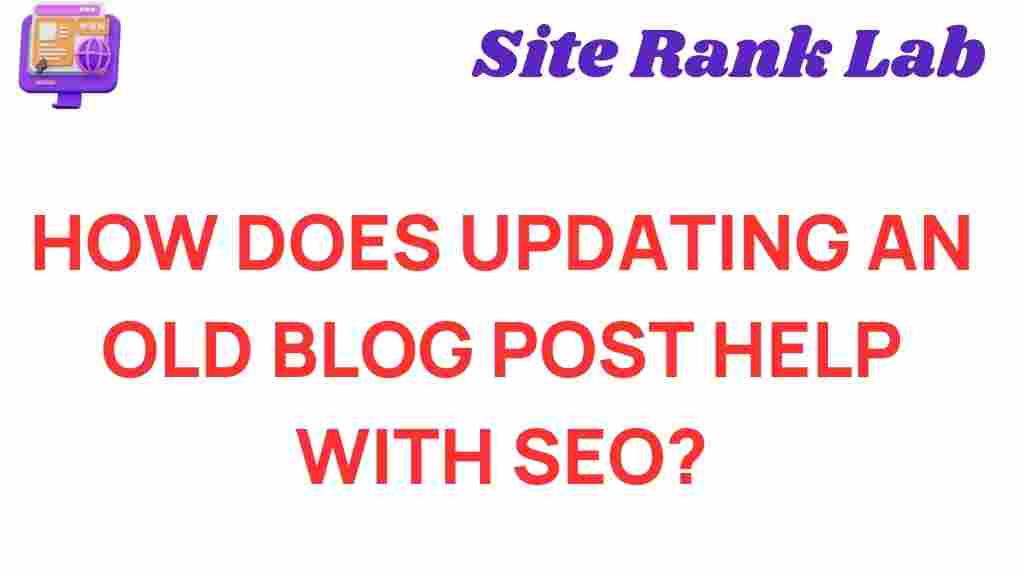Unlocking SEO Potential: The Power of Updating Old Blog Posts
In the ever-evolving landscape of digital marketing, maintaining a robust online presence is crucial. One strategy that often gets overlooked is updating old blog posts. This approach can significantly enhance your SEO efforts, improve website ranking, and increase organic traffic. In this article, we will explore the importance of blog post updates as part of a comprehensive content strategy and how you can effectively implement this practice to reap the benefits of search engine optimization.
Why Update Old Blog Posts?
Before diving into the methods of updating your blog posts, it’s essential to understand why this practice is beneficial:
- Enhances Content Relevance: As trends change, so does the relevance of your content. Regular updates ensure that your posts remain current and useful to readers.
- Improves Search Engine Ranking: Search engines favor fresh content. Updating your posts can help improve their position in search results.
- Increases Organic Traffic: By optimizing old posts, you can attract new visitors and retain existing ones, boosting your overall traffic.
- Strengthens Backlinks: High-quality, updated content is more likely to attract backlinks, which are crucial for SEO.
Step-by-Step Process to Update Old Blog Posts
Now that we’ve established the importance of updating old blog posts, let’s break down a step-by-step process on how to effectively do it:
1. Identify Posts That Need Updating
Start by reviewing your blog to identify posts that are outdated or underperforming. Look for:
- Posts with low traffic over time.
- Content that is no longer relevant or factual.
- Articles that are missing recent statistics or trends.
2. Analyze Post Performance
Utilize tools like Google Analytics to assess the performance of your blog posts. Look for:
- Page views
- Bounce rates
- Average time on page
Posts with high bounce rates or low engagement might need a refresh.
3. Update Content for Relevance
Once you’ve selected the posts to update, focus on enhancing their content:
- Refresh Statistics: Always include the latest data, statistics, and trends relevant to the topic.
- Add New Information: Incorporate any new developments or insights that may have emerged since the original post.
- Improve Readability: Break up large blocks of text, add bullet points, and use subheadings to enhance readability.
4. Optimize for SEO
As you update, keep SEO best practices in mind:
- Use Relevant Keywords: Incorporate your focus keywords naturally throughout the content.
- Optimize Meta Tags: Update the meta title and description to reflect the new content.
- Check Internal Links: Add links to other relevant posts on your site to encourage further reading.
5. Promote the Updated Post
Once your blog post is updated, it’s time to promote it:
- Share on Social Media: Post on your social media channels to reach a broader audience.
- Email Newsletter: Notify your subscribers about the updated content.
- Consider Paid Promotion: If the content is significant, consider using paid ads to promote it further.
Troubleshooting Tips for Blog Post Updates
While updating old blog posts can yield great results, there are a few challenges you might encounter. Here are some troubleshooting tips:
- Content Too Outdated: If a post is severely outdated, consider rewriting it completely instead of just updating it.
- Low Engagement Even After Updates: If a post still isn’t performing well, it may be time to remove it or redirect it to a more relevant page on your site.
- SEO Issues: If you’re unsure about your SEO practices, consult an expert or use online tools to check your optimization.
Conclusion
Updating old blog posts is an often overlooked yet powerful component of a successful content strategy in the realm of digital marketing. By refreshing your content, you not only enhance its relevance but also improve your website ranking and increase organic traffic. Remember, the goal of search engine optimization is to provide value to your audience, and regularly updating your content ensures that you are doing just that.
For more tips on enhancing your content strategy, visit this resource. If you are looking for comprehensive tools for SEO, check out these tools that can help streamline your efforts.
Embrace the power of content refresh today, and watch as your blog transforms into a more effective tool for attracting and retaining readers!
This article is in the category SEO and created by SiteRankLab Team
